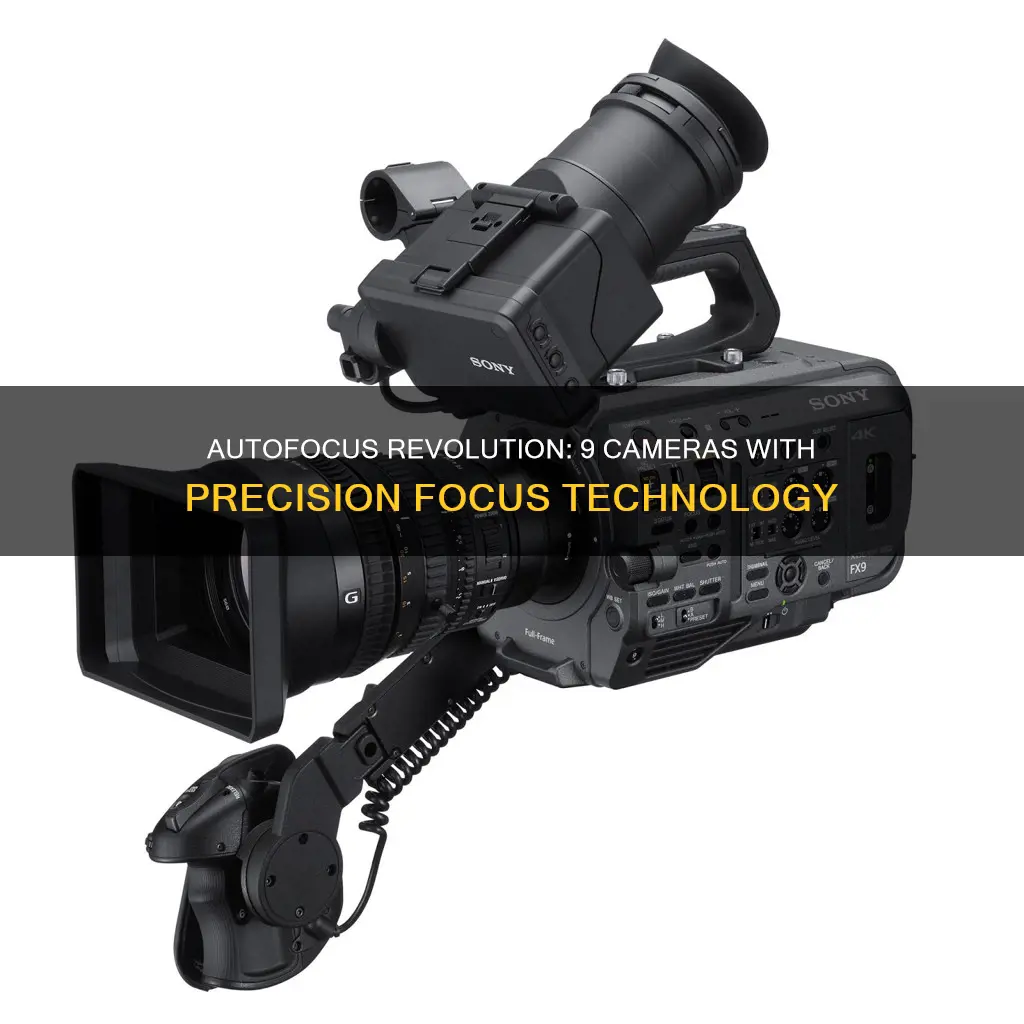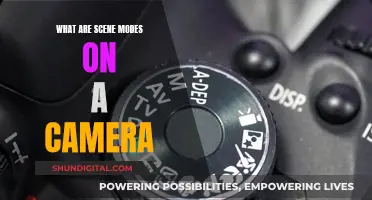
Autofocus (AF) is a function of a camera that automatically focuses on a subject. The AF system uses a sensor, a control system, and a motor to focus on a selected point or area. The AF system can be categorised as active, passive, or hybrid. The number of autofocus points varies across cameras, with some having 9, 11, or 51 points. The more AF points a camera has, the more options are available to fine-tune the focus.
| Characteristics | Values |
|---|---|
| Type of AF System | Active, Passive, or Hybrid |
| Type of AF Method | AF-S, AF-C, AI Servo, One-Shot, etc. |
| Number of AF Points | 9, 11, 51, or more |
| AF Point Coverage | Varies, but can reach edges of frame |
| AF Point Selection | Manual, Automatic, or Hybrid |
| AF Assist | Yes or No |
What You'll Learn

Autofocus (AF) vs Manual Focus (MF)
Autofocus (AF) and Manual Focus (MF) are two distinct camera focusing modes, each offering unique advantages to photographers.
Autofocus (AF)
Autofocus is a function in most digital cameras that automatically focuses on a subject. AF offers various methods, depending on the camera model, such as Single-shot AF (AF-S) and Continuous AF (AF-C). AF-S locks the focus when the shutter button is pressed halfway, making it suitable for motionless subjects. On the other hand, AF-C continuously adjusts the focus while the shutter button is held down, ideal for capturing moving subjects. Some cameras also offer Direct Manual Focus (DMF), allowing fine-tuning after autofocusing. AF is beneficial when starting out in photography, working alone, or capturing fast-moving subjects. It frees up attention for other aspects like exposure and lighting and is useful in unpredictable situations. AF is also advantageous for vlogging, self-shooting, and B-roll footage. The latest advancements include face/eye detection, where the camera detects and focuses on faces, making it ideal for vlogs, interviews, and documentaries.
Manual Focus (MF)
Manual focus gives photographers complete control over the camera's focusing. It is activated by switching from AF to MF on the lens or camera body. MF is crucial in low-light conditions, macro photography, and shallow depth-of-field shots, where precise focusing is essential. It is also useful when the autofocus struggles, such as in dimly lit environments or when shooting through glass or wire fences. MF ensures the desired focal point is achieved, especially when shooting portraits, as it allows focusing directly on the eyes or other specific facial features. Additionally, MF is beneficial for action photography, allowing photographers to pre-focus on a point that a moving subject will pass through. While MF requires practice, it empowers photographers to make precise adjustments, ensuring the desired outcome.
The choice between AF and MF depends on the photographer's needs and preferences. AF offers convenience and ease of use, especially for beginners and those working solo, while MF provides ultimate control over the camera's focus, making it ideal for specific scenarios like low-light conditions and macro photography.
Understanding ASD Mode: Camera Setting Explained
You may want to see also

Active vs Passive AF
Autofocus (AF) systems can be either active or passive. Active AF systems measure the distance to the subject independently of the optical system and then adjust the focus of the lens. Passive AF systems, on the other hand, determine the correct focus by performing an analysis of the image entering the optical system.
Active AF
Active AF systems emit a red beam of light onto the subject and then bounce that light back to the camera to calculate the distance between the camera and the subject. The camera then instructs the lens to adjust its focus based on this information. Active AF is useful in low-light environments where passive AF does not function. However, it can only be used for stationary, non-moving subjects and only works for close subjects.
Passive AF
Passive AF systems work in one of two ways: Phase Detection or Contrast Detection. Phase Detection uses an array of microlenses to split light into a pair of images. The distance between these images is then measured to determine whether the subject is in front or back focus. The camera then uses this information to instruct the lens to adjust its focus. Phase Detection AF is very fast, making it ideal for tracking fast-moving subjects.
Contrast Detection AF, on the other hand, uses software algorithms to "probe" through areas of an image for edge detail. The camera scans the scene and rapidly changes focus from foreground to background until the subject is in focus. Contrast Detection AF is generally slower than Phase Detection AF but is more reliable and accurate in low-light conditions.
Hybrid AF
Some cameras combine both Phase Detection and Contrast Detection AF to create a hybrid AF system. This allows the camera to switch between the two methods depending on the environment, taking advantage of the strengths of each system.
Comparison of Active and Passive AF
Active AF systems will not focus through windows as the light is reflected by the glass. They are also less accurate than passive systems and may fail to focus on subjects that are very close to the camera. Passive AF systems, on the other hand, may struggle to find focus when the contrast is low, such as on single-coloured surfaces or in low-light conditions. Passive systems require a certain degree of illumination, while active systems can focus correctly even in total darkness.
Avoid Camera Tickets: Tips to Keep Your Record Clean
You may want to see also

Phase Detection vs Contrast-Detection AF
Autofocus (AF) is a standard feature of modern digital cameras, allowing photographers to capture sharp images with ease. There are two main types of autofocus systems: phase detection and contrast detection. Both methods rely on detecting contrast to achieve accurate autofocus, but they differ in terms of speed, accuracy, and the technology they employ.
Phase Detection AF
Phase detection autofocus is often found in DSLR cameras and is known for its speed and ability to track fast-moving subjects. This system uses an array of microlenses that split incoming light into a pair of images. By measuring the distance between these images, the camera can determine how far the lens needs to adjust its focus. This process is fast and precise, making it ideal for sports and wildlife photography.
However, phase detection has some limitations. It struggles in low-light conditions and with low-contrast subjects. Additionally, it may not be as accurate when using wide apertures due to mechanical tolerances. Phase detection also requires more technology inside the camera, which can increase the size and cost of the device.
Contrast Detection AF
Contrast detection autofocus, on the other hand, is commonly found in mirrorless cameras and is known for its accuracy, especially with still subjects. This system uses software algorithms to analyse edge detail and contrast within the image. The camera rapidly adjusts the focus from foreground to background until the subject is sharp. While this process is generally slower than phase detection, it is more reliable in low-light conditions.
Contrast detection has the advantage of being less expensive and more compact. It does not require additional hardware, as it relies solely on the camera's image sensor. However, the need to push and pull the lens to lock focus can make this system slower, especially when tracking moving subjects.
Hybrid AF Systems
Some cameras, including certain DSLRs and mirrorless models, employ a hybrid of phase detection and contrast detection autofocus systems. For example, a DSLR camera may use contrast detection AF in Live View or movie mode and phase detection AF when using the optical viewfinder. This combination allows photographers to benefit from the strengths of both systems, depending on their specific needs.
Converting ICC Profiles to Camera Raw: A Quick Guide
You may want to see also

Continuous AF (AF-C) vs Single AF (AF-S)
Single autofocus mode (AF-S) is the most basic autofocus option. When you select this mode, the camera will lock the focus on the subject you want to photograph. If the subject moves, you will have to focus again. AF-S is best for static subjects, such as portraits, macro, and architecture.
Continuous autofocus mode (AF-C) is best for moving subjects. Once you set your focus, the camera will continue to track the subject, even if they move around within the frame. AF-C is more complex than AF-S because the autofocus speed and tracking algorithms depend on the type of subject, how fast and how unpredictably it moves. AF-C takes more processing power and lens adjustments, making it a greater drain on battery life.
AF-S and AF-C are the two most popular autofocus modes. However, some cameras also have a hybrid autofocus mode (AF-A) that automatically switches between AF-S and AF-C depending on whether the subject is moving or not.
Mastering Camera Focus for Creative Forced Perspective Shots
You may want to see also

AF Point Selection
The number of autofocus (AF) points a camera has is a key factor in the robustness and flexibility of its autofocus capabilities. AF point selection is the process of choosing which of these points the camera will use to focus on a subject.
Most camera modes more advanced than 'Auto' allow the photographer to select which AF points to use. This can be done using a dedicated AF point selection button, or by accessing the AF settings in the camera's menu.
For 95% of photography, it is recommended to only use the centre autofocus point. This means that the photographer must point the camera directly at the part of the scene they want to be in focus when they half-press the shutter button to focus. However, by setting the focus mode to 'Single Shot' or AF-S, the photographer can then reframe the shot after focusing by keeping their finger on the shutter button, allowing them to apply the rule of thirds for better composition.
Different types of AF points include vertical, horizontal, cross-type, and dual cross. Cross-type and dual cross AF points are more sensitive and therefore more effective than standard AF points.
Adjusting Tinyhawk Camera Focus: A Step-by-Step Guide
You may want to see also







